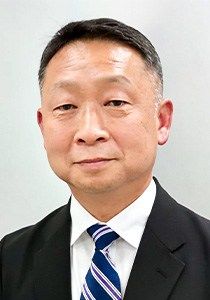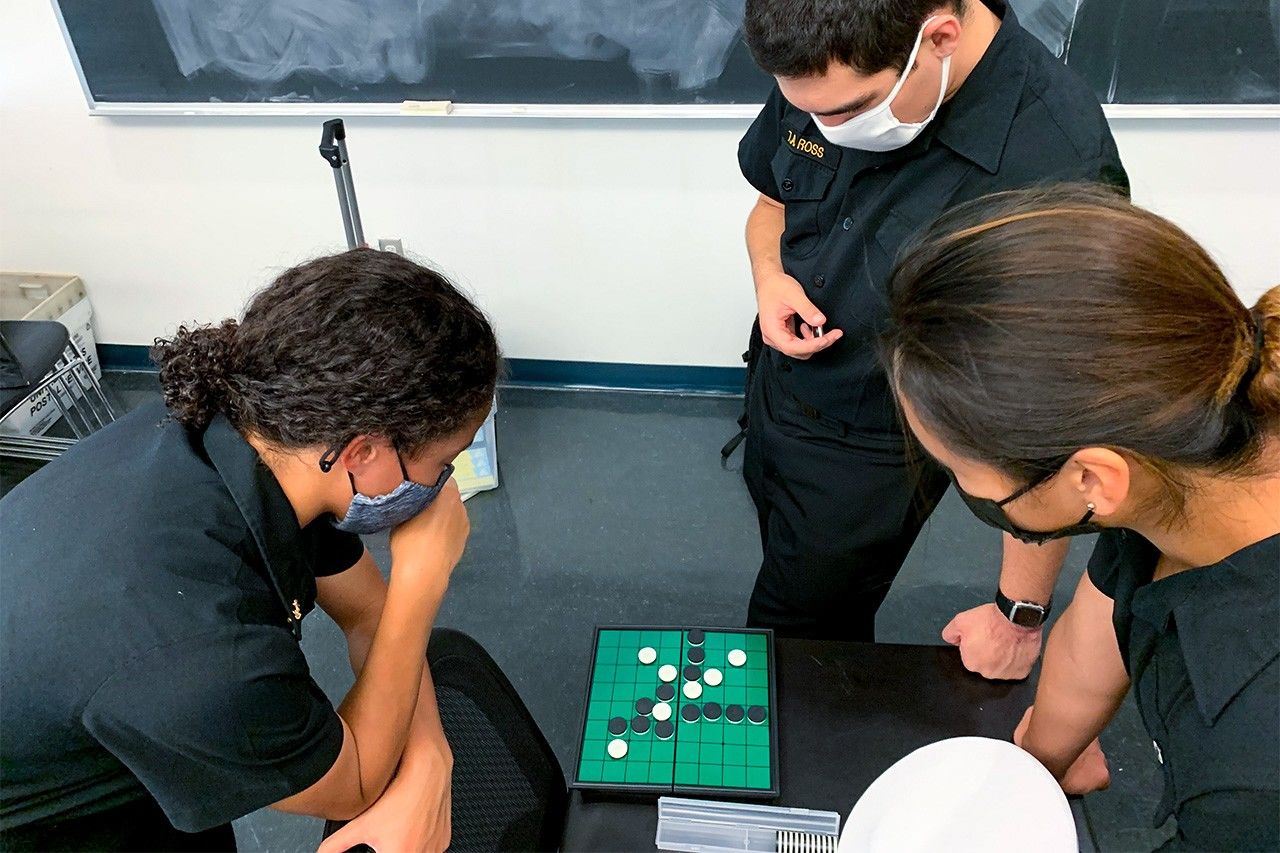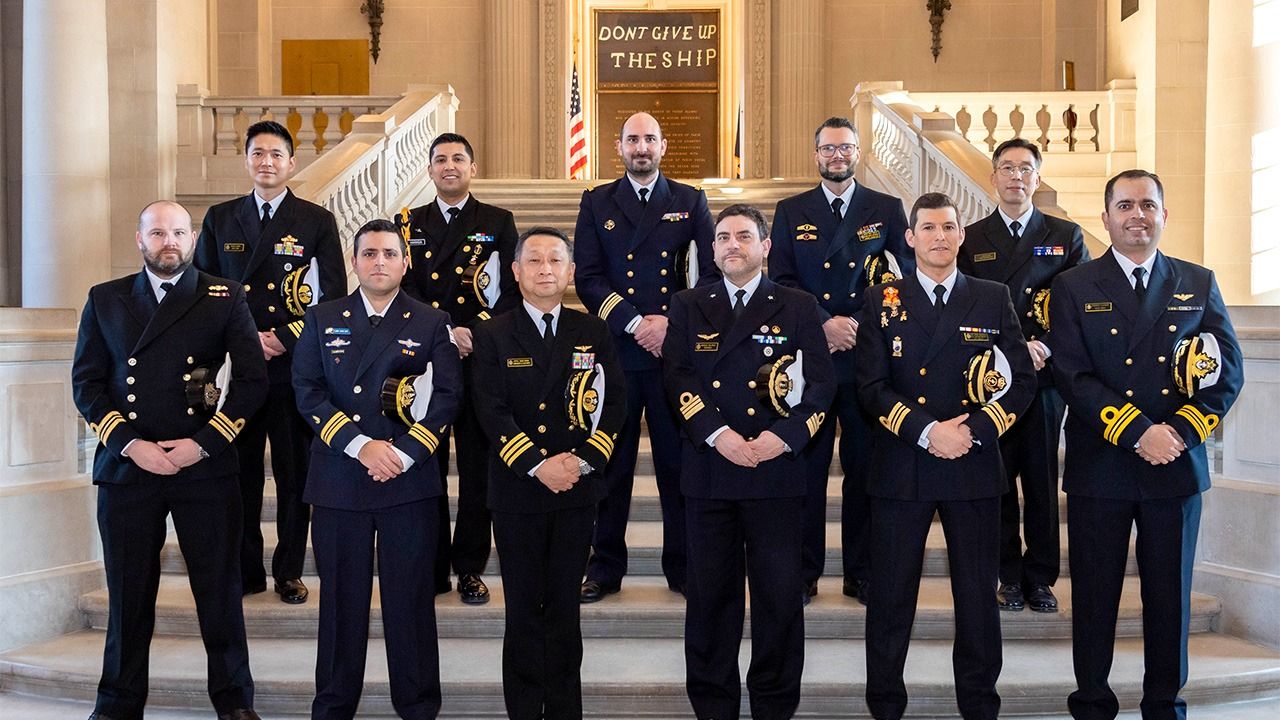
Building Bridges with US Naval Counterparts: A Japanese Annapolis Instructor on the Key to US-Japan Security
Politics World- English
- 日本語
- 简体字
- 繁體字
- Français
- Español
- العربية
- Русский
The Naval Academy Develops Core Leaders
INTERVIEWER How did you come to be assigned to the US Naval Academy?
MAEYAMA IPPO I was assigned an instructor at the Japan Maritime Self-Defense Force Command and Staff College while doing graduate studies at Keiō University when I was unexpectedly offered a position at Annapolis. I served as a P-3C pilot at Kanoya in Kagoshima Prefecture and Iwakuni in Yamaguchi Prefecture. After the 9/11 attacks, I served as a liaison officer at the US Pacific Command in Hawaii and later as a liaison officer in Bahrain for refueling support operations in the Indian Ocean. I also participated in the journalism program at the Sankei Shimbun newspaper. After the March 2011 Great East Japan Earthquake, I was the assistant public affairs officer in the Joint Staff Office, Tokyo.
INTERVIEWER I imagine when most people think of Annapolis, their first thought is of the Richard Gere movie An Officer and a Gentleman, but what is the school really like?
MAEYAMA The Naval Academy is the same as an east coast liberal arts college, and it is developing some of the United States’ core leaders, not only military leaders but also people who go on to the federal government, political, and business fields after leaving the military. Midshipmen are obligated to serve five years in the military after graduation, but they can choose a military career or pursue another profession. Each class has about 1,100 graduates, and the alumni are a diverse group, including President Jimmy Carter, Senator John McCain, Apollo 13 Commander Jim Lovell, and even some Nobel prize winners.
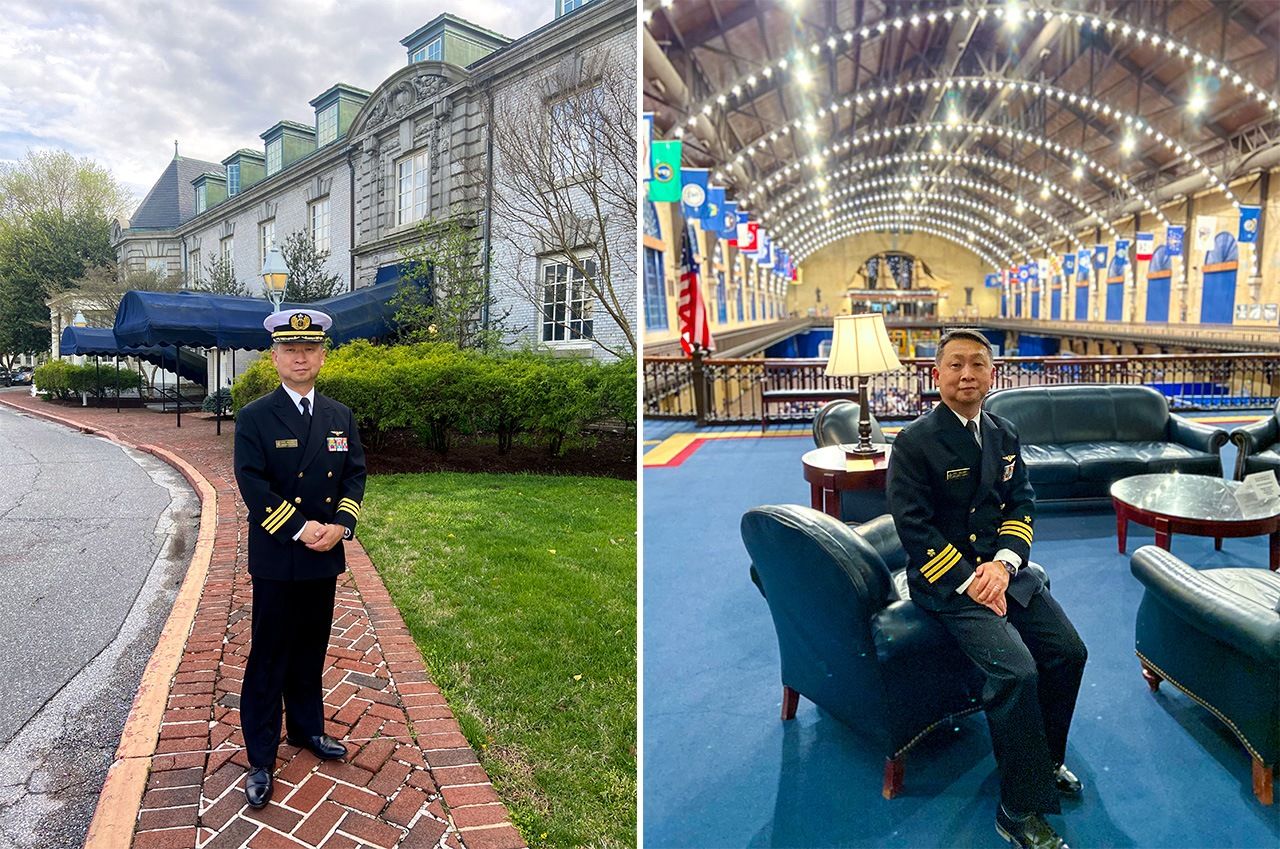
Maeyama in front of the Naval Academy’s Officers’ Club (left), and in the multipurpose Dahlgren Hall.
INTERVIEWER Can you tell us about the students and courses you taught during your six-year tenure?
MAEYAMA I was assigned to the Language and Culture Department, where I was in charge of teaching Japanese and culture. It was an elective course, and while some midshipmen were Japanese-Americans, others had been active in Japan as missionaries. Around 250 students take Japanese courses each year, with beginner, intermediate, and advanced levels available. I designed and developed the class to raise the level of cultural knowledge so that midshipmen would not be embarrassed as US Navy or Marine Officers when they were assigned to Japan after graduation to work with Japanese-educated people. The advanced courses, for example, included reading works by Shiba Ryōtarō and Hoshi Shin’ichi, or going through Ikenami Shōtarō’s Otoko no sahō (A Man’s Etiquette) to learn the proper way to eat sushi or soba.
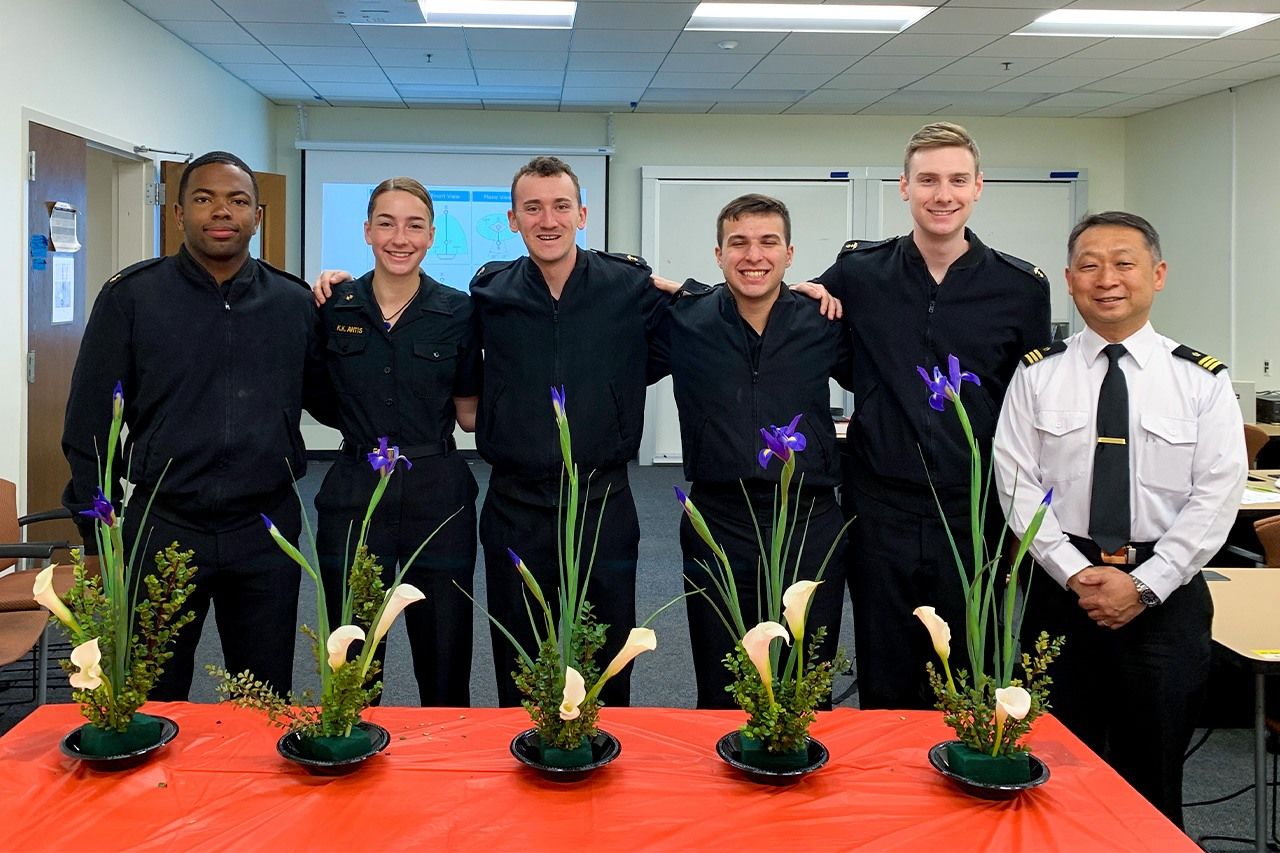
Midshipmen showing off their ikebana as part of a cultural experience section of a beginners’ conversation class with Maeyama.
Students Weep During Eien no 0 (The Eternal Zero)
INTERVIEWER Did your lessons highlight any differences between how Americans and Japanese people think?
MAEYAMA I was particularly surprised at the cultural differences revealed when we read Akutagawa Ryūnosuke’s “Kumo no ito” (trans. “The Spider’s Thread”). In the story, the Buddha Shakyamuni decides to save the main character of Kandata because he once spared the life of a spider he nearly stepped on. I was often surprised by the very thoughtful, well-reasoned questions that students asked, such as about minor differences in kanji usage, or why the Buddha felt it was right to offer salvation to a soul that had been condemned after repeated trials by Enma, the ruler of hell, all on a simple whim.
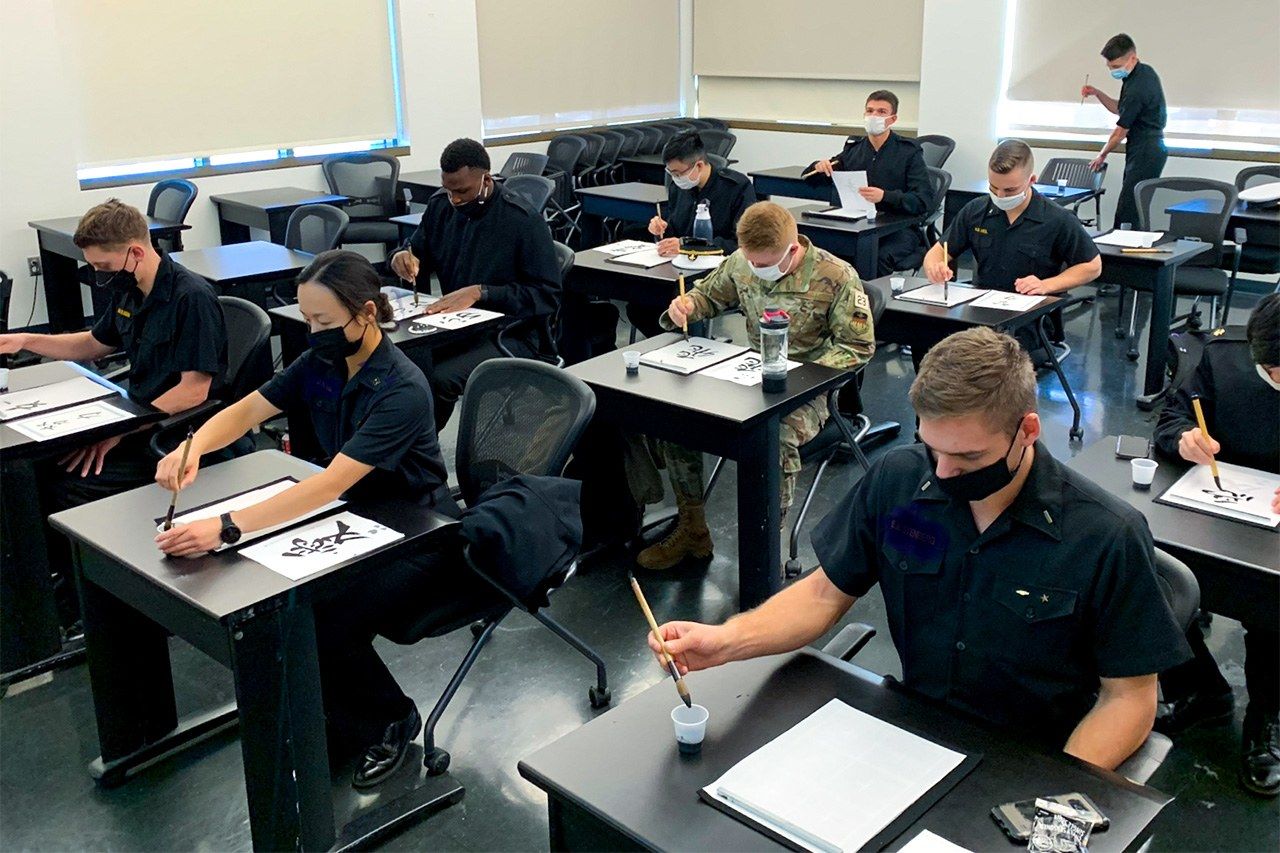
Midshipmen in the Japanese-American club practicing calligraphy.
INTERVIEWER What differences did you see in values or attitudes toward the military?
MAEYAMA It was a bit risky, but in the class I covered the movie Eien no 0 [The Eternal Zero], based on a book by Hyakuta, depicting kamikaze pilots. Of course, the midshipmen were on the US side, so they placed themselves in the actual position of being under attack, but I wanted to give them the perspective that the Zero fighter pilots were human, young people of the same age, with their own families, lovers, and dreams of future lives. The story deeply touched my students. They have no feelings of hatred toward the former Japanese military. Instead, I believe they have a very humble feeling that the United States was able to defeat a powerful enemy, Imperial Japan, at a high cost. I felt that Japan and the United States share the martial spirit of Bushidō, or the sense of respect fostered by placing one’s life on the line as a warrior.
INTERVIEWER What can you tell us about the attitude or culture at Annapolis?
MAEYAMA If I had to use one word, it would be “humble.” This is the spirit and school culture of all Naval Academy graduates. Students must have excellent grades and athletic ability, as well as a proven leadership record, to be admitted, and admission also requires letters of recommendation from the president, vice president, or a member of Congress. New “plebe” students often show up in June each year with plenty of pride in their hearts, but the first six weeks of their experiences at the yard, known as Plebe Summer, is a time of difficult training that results in real change. Senior midshipmen give strict military challenges, and one thing they ask plebes is, basically, “You’ve been told you’re the top, or the best. But here, it’s the norm. What can you guys do for our country now?” By the end of the Plebe Summer, the first-year students have a budding sense of humility.
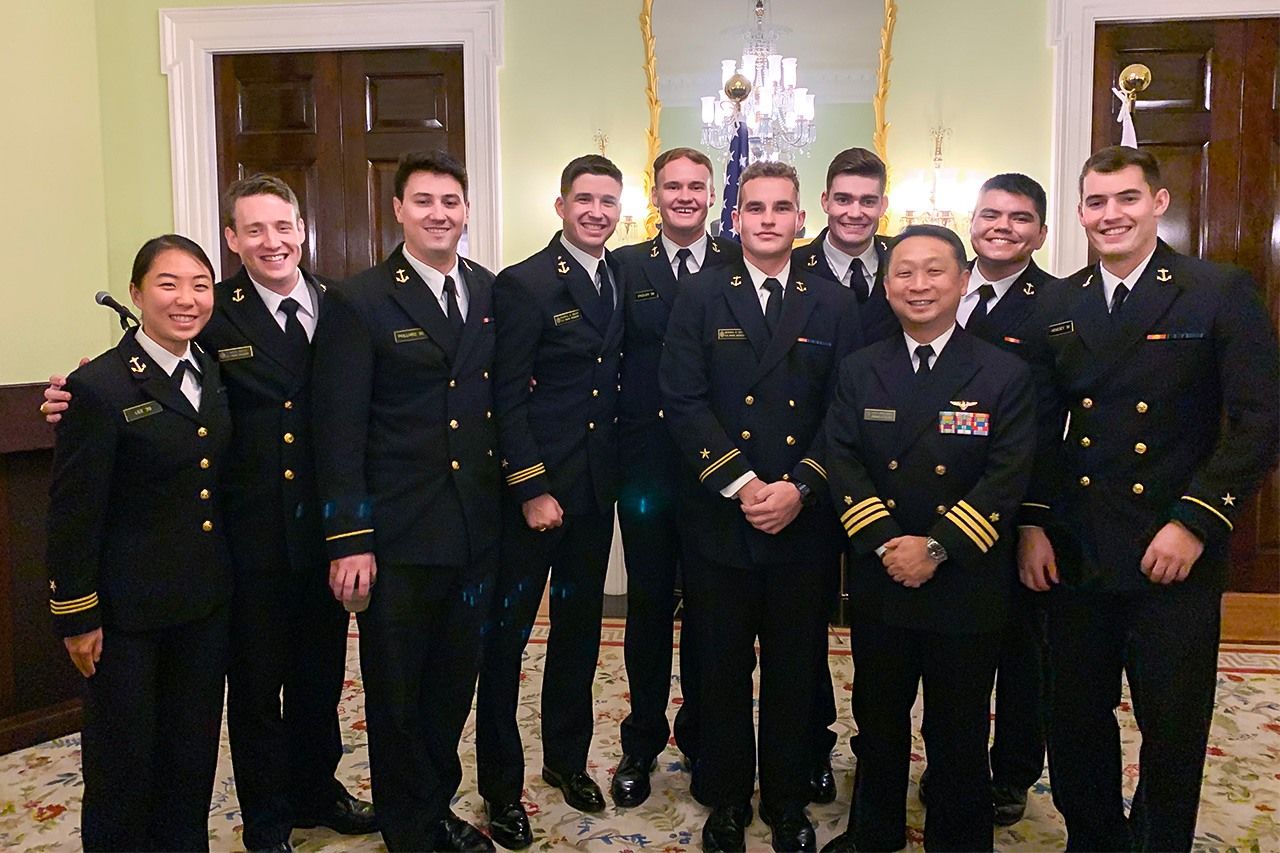
Maeyama stands with midshipmen scheduled for assignments in Japan.
INTERVIEWER The Naval Academy in Annapolis is roughly equivalent to Japan’s National Defense Academy. What are some differences or similarities between the two?
MAEYAMA The US Naval Academy has an extreme academic focus. Students who get admitted are at around the same level as Ivy League students, and classes are small—no more than 20 students—with no large lecture halls. There are 1,600 professors and officers for around 4,500 students. Between quizzes, midterms, and final exams, it’s not at all rare for students to spend all night studying. You could say that the road to graduation is much more complex than in Japan. The Naval Academy also confers a bachelor of science degree on graduation.
An Unrepresented Leading Nation
INTERVIEWER What is your most lasting impression from Annapolis?
MAEYAMA The Naval Academy has the only college cyber security studies major in the United States. Japan still lags far behind in advanced education in fields like intelligence analysis and cyber operations. The United States places a lot of emphasis on STEM, or science, technology, engineering, and mathematics, education. Although there’s an argument about whether military training or academic study should be the priority for these 18- to 22-year-olds, the Naval Academy clearly has a strong focus on academics. Developing academic research and logical thinking skills helps foster American leaders who can make the most appropriate decisions and act no matter what the situation. There is no doubt in such a way of thinking.
INTERVIEWER Did you learn anything that could help improve officer education in Japan?
MAEYAMA Japan sent exchange students to the United States Naval Academy from the 1869 to 1906. The most famous is Admiral Uryū Sotokichi, who served effectively in the Russo-Japanese War, but the practice ended in the early 1900s. By 1940, there were no more Japanese naval officers who had attended Annapolis. No matter the age, I believe the bonds formed during those four years of youth are strong. The personal connections between Japan and the United States helped bridge the two countries politically and economically. Losing that valuable network closed off many pathways to settling various problems between the United States and Japan, which also helped lead to the horrors of war.
INTERVIEWER How many international students are there at the Naval Academy?
MAEYAMA There are just under sixty students from twenty-nine countries. There are three each from Korea and Taiwan. The United States has a lot of expectations and trust for Japan, but there are currently no students from the JSDF. Although several students from both sides are sent on the semester exchanges program, I think it’s essential as a national strategy for Japanese midshipmen from Japan to study at the US Naval Academy for the entire four years.
Welcoming More Japan Fans
INTERVIEWER What do you think was your most significant success as an instructor at Annapolis?
MAEYAMA I think it was achieving an increase in Japan fans. When I took up my appointment in the fall of 2016, students’ interest in Japan was declining, and Japanese language enrollment had dropped from 3.2 percent to 2.6 percent of the student body. There was a strong sense of urgency in the department, so we revamped our courses. We were able to recover enrolment and stabilize at 3.8 percent as of the first half of 2020. The Japanese-American Club, where I served as the representative officer, increased membership from 50 to 500.
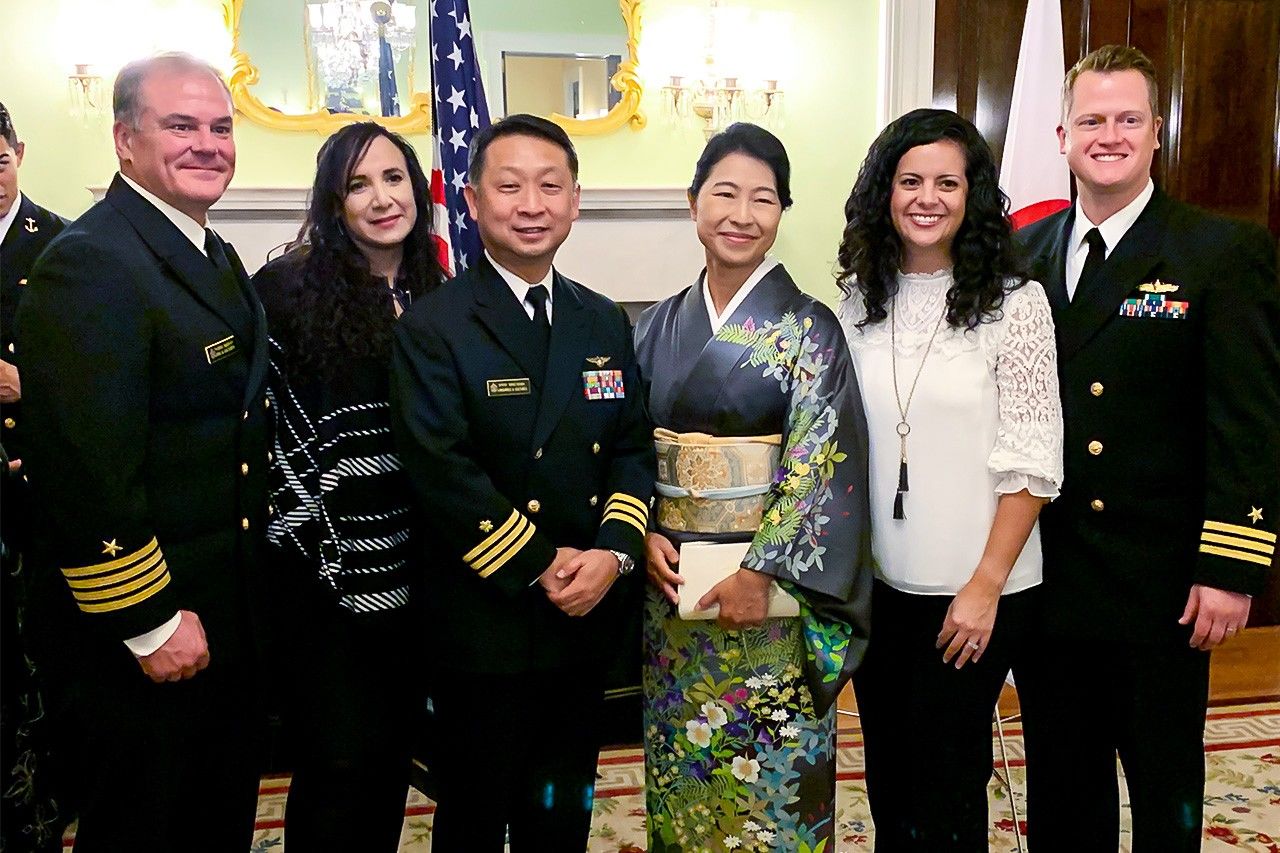
Maeyama and his wife pose with colleagues at the former official residency of the Japanese ambassador.
INTERVIEWER What efforts or ideas did you come up with?
MAEYAMA I took my wife, daughter, and dog to Annapolis. We worked together as a family to do events like a kaigun karē [traditional Japanese navy-style curry and rice] tasting party for students, or a “Japanese-style” barbecue centered on home-cooking like nikujaga stewed beef and potatoes, kara-age fried chicken, sushi rolls, onigiri rice balls, and more. At first, only five or six students volunteered to join, but over time popularity grew, and it became a regular event attracting around seventy students each time.
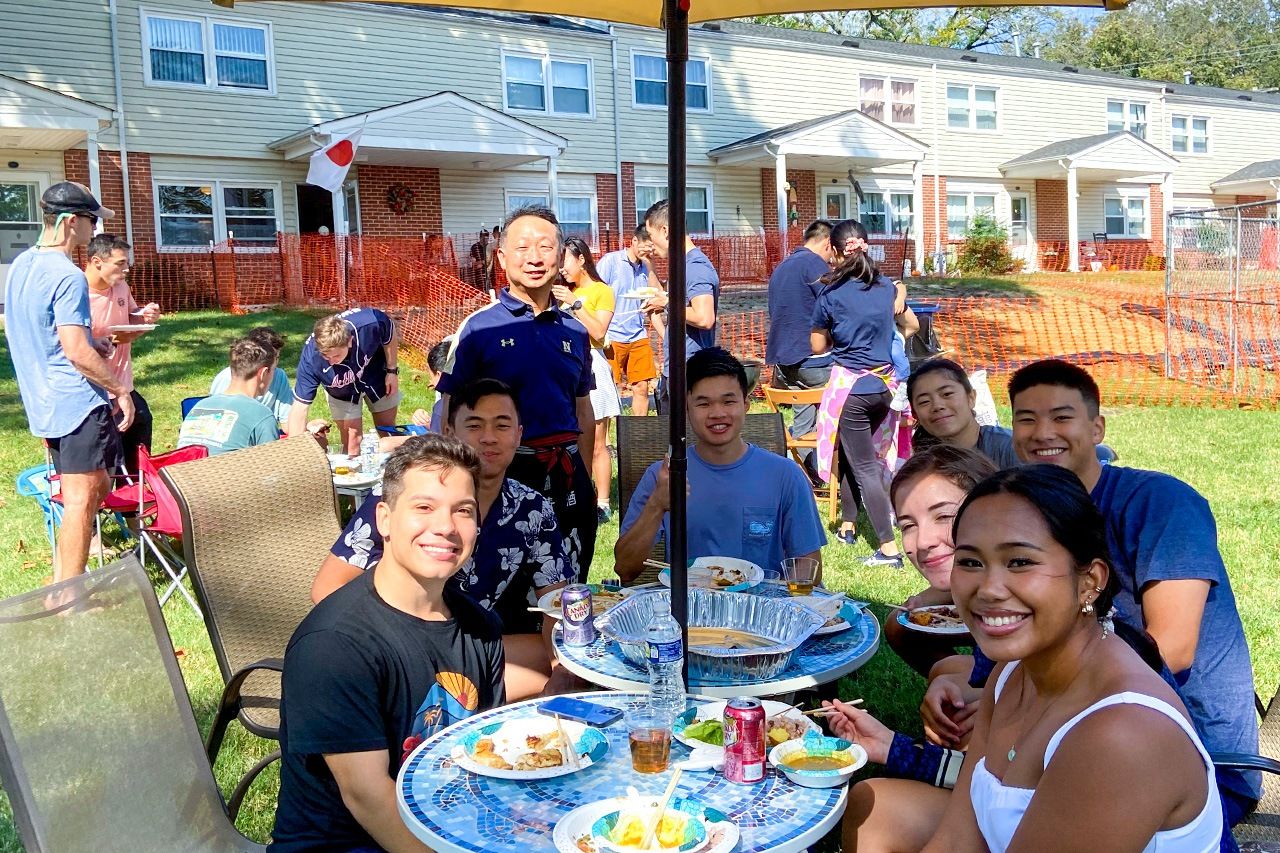
Midshipmen enjoy Japanese home-cooking at the Maeyama barbecue.
Annapolis also has a significant event every January or February called Ship Selection, where the midshipmen who will serve as surface warfare officers—in other words, ship drivers—can choose their first ship for assignment. Some 250 midshipmen take the stage in order of academic and military training grades standing and choose a Navy ship nameplate, while their classmates and juniors look on. There are American naval bases in Japan at Yokosuka, Kanagawa Prefecture, and Sasebo, Nagasaki Prefecture. In 2018, I came up with a new idea. I started presenting an iaigatana, an unsharpened sword for training purposes, to the first student to choose Japan as a first assignment, as a sign of friendship between our two navies. The television news featured it as a “US-Japanese naval tradition” in 2019, and it even became famous in the US Navy. Then, the top student in both 2020 and 2021 chose Yokosuka.
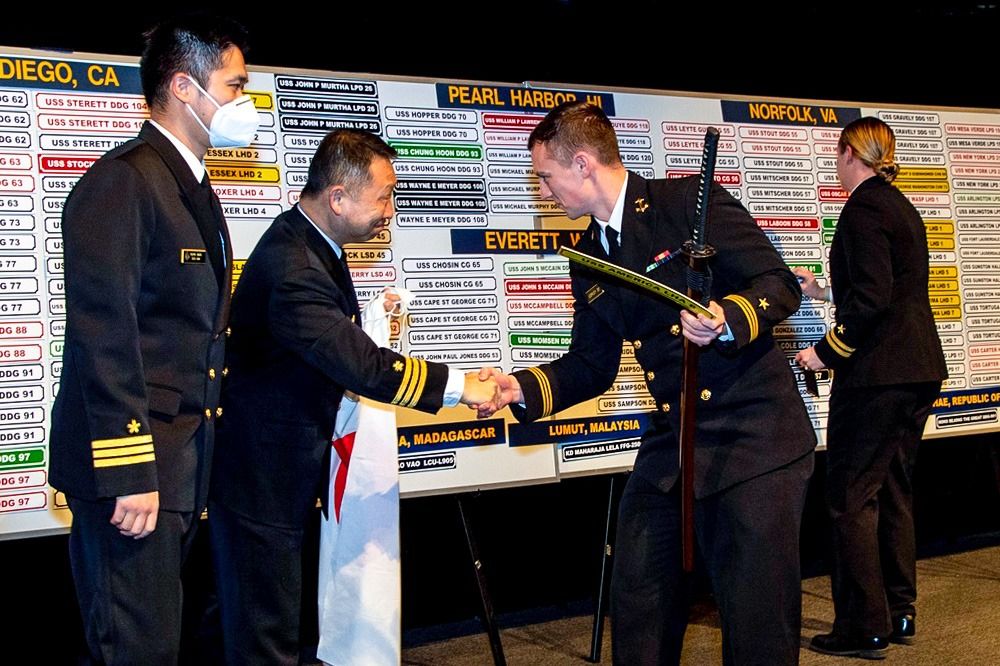
Maeyama presents a ceremonial sword to signify Japan-US Navy friendship to the first midshipman to choose a Japan-based assignment at Ship Selection.
INTERVIEWER What can you tell us about how American and Japanese officers should relate in the future? What is the key to this relationship?
MAEYAMA One thing I felt keenly at Annapolis is the absolute necessity of staff interoperability. The US Navy is approaching this problem through the Education for Seapower, or E4S, initiative. This is an idea that promotes higher education and requires at least a master’s degree for promotion to captain or colonel. So, from the Japan-US alliance perspective, what are we going to do about the balance of knowledge and human interoperability with US Naval officers who have gone through graduate school? E4S analysis shows that knowledge is a particularly key factor in modern warfare. Considering all of that together, I believe that, first and foremost, it is essential for Japan’s strategy to take advantage of Annapolis as a place where Japanese and American youth can build profound relationships and share intellectual training.
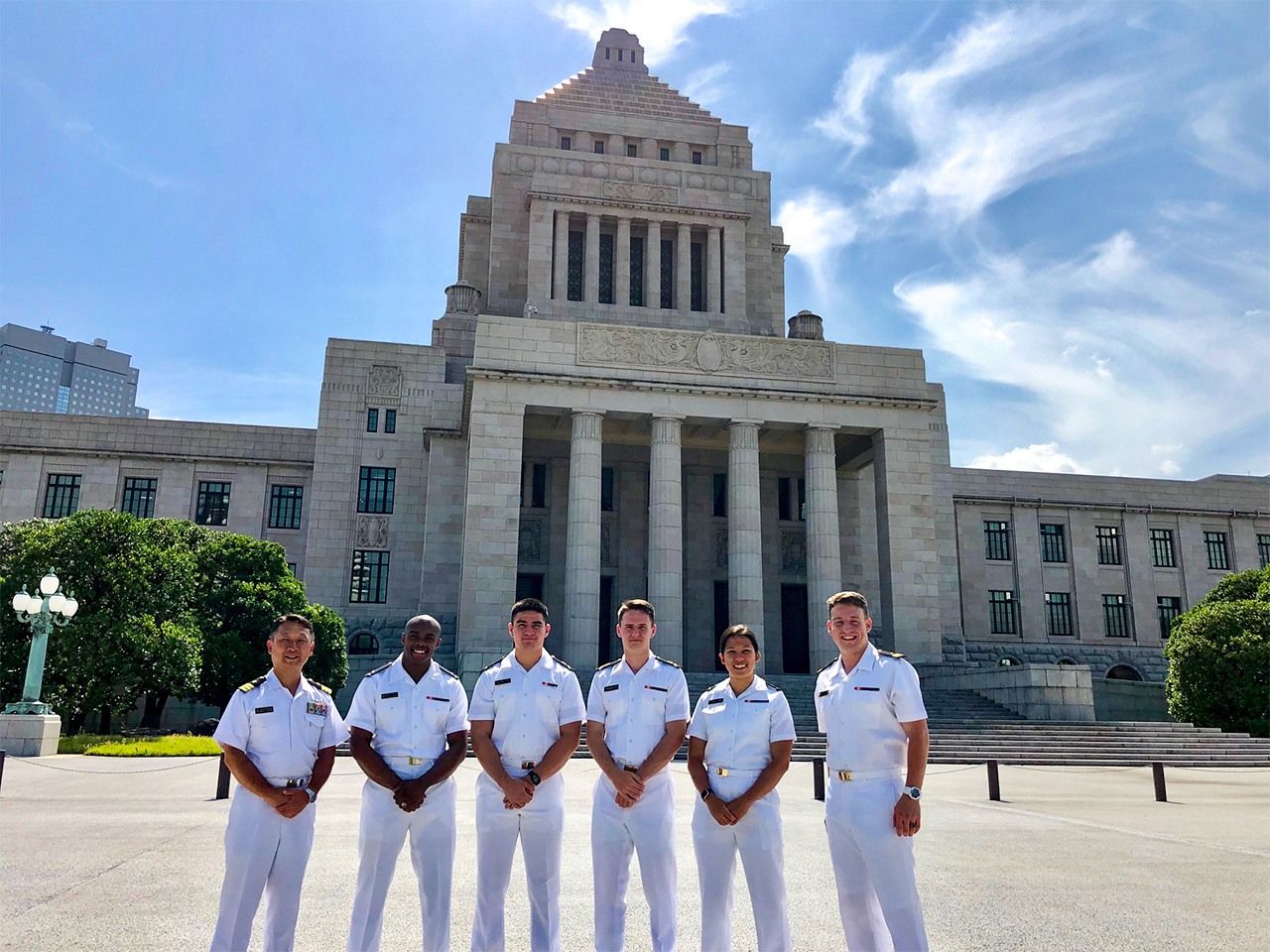
Maeyama shows midshipmen around the National Diet Building during a study tour in Japan.
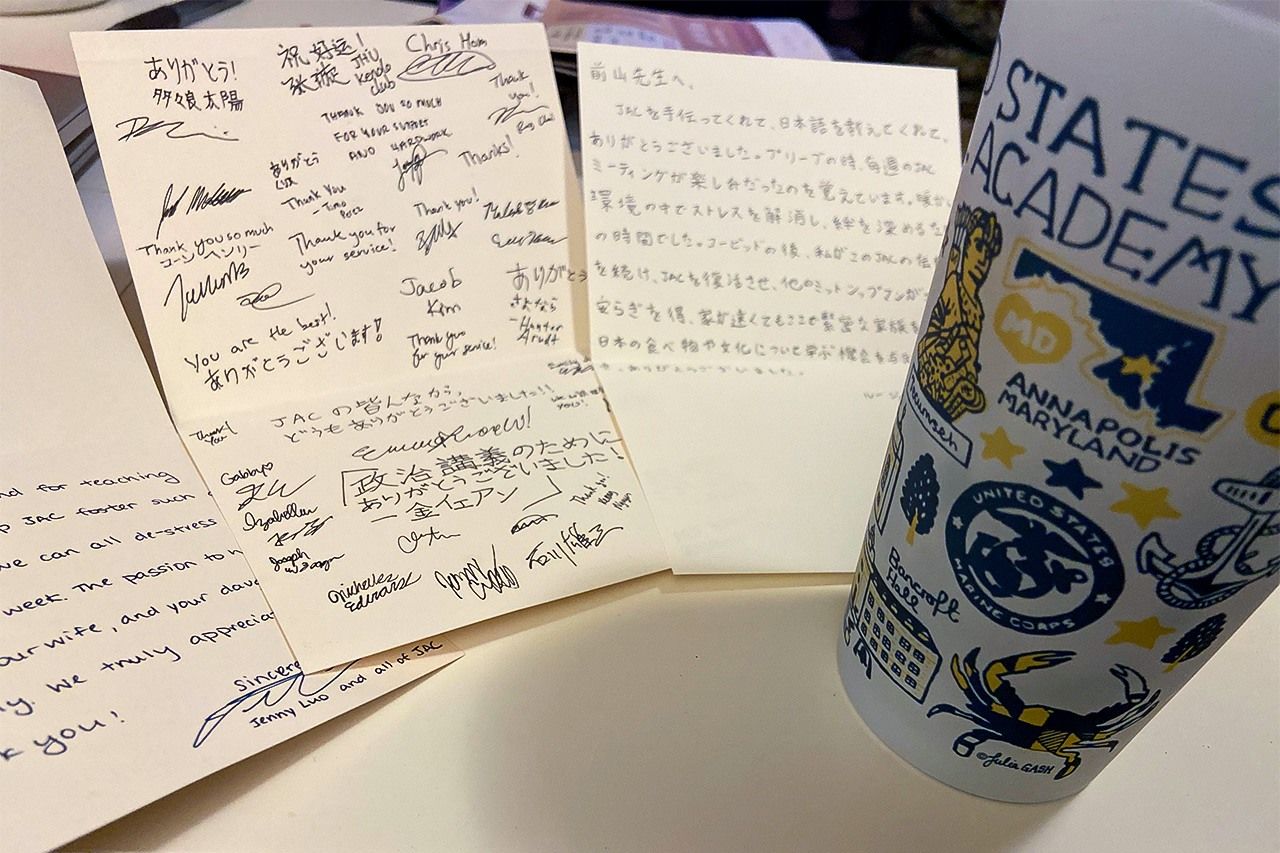
A collection of notes sent to Maeyama from students on the occasion of his retirement as a Naval Academy instructor.
(Originally published in Japanese on July 4, 2022. Banner photo: Maeyama poses for a commemorative photo with exchange officers deployed to Annapolis from various navies. All photos courtesy of Maeyama Ippo.)
SDF US military navy exchange US-Japan alliance US Marine Corps
